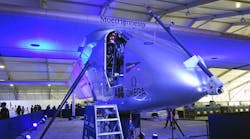MONACO, Monaco—At the control center of the sun-powered Solar Impulse 2 plane, Swiss pilot and project co-founder Bertrand Piccard explains why his colleague Andre Borschberg had to make an unplanned stop in Japan in the middle of an historic round-the-world voyage. Here, he talks with AFP reporter Catherine Marciano.
Q: The Solar Impulse 2 took off Saturday from Nanjing (eastern China), and was supposed to arrive in Hawaii after six days and six nights. What happened?
A: When we left China, the weather conditions as far as Hawaii were okay. Then they got worse. We didn't expect to fly through an active weather front, with ice, rain and turbulence. It's a plane that flies slowly and is sensitive to turbulence, and it needs sun to be able to recharge its batteries.
On the fifth day of the flight the front got stronger. We will never be able to finish a round-the-world trip if we crash in the middle of the Pacific.
This world tour is maybe not going as fast as we would like, but this is not a race. The goal is to get there.
In terms of safety, it was much better to make an intermediate landing in Nagoya and to wait there for the weather to improve. It was the last place we could safely land. The little islands dotted here and there in the Pacific are by no means an alternative.
Q: Failure or technical feat?
A: We're a little disappointed to not have been able to fly non-stop from China to Hawaii. But a plane that flies 40 hours without fuel, only on solar power, is already extraordinary. We're extremely happy with the performance of this plane. The technical feasibility is there. This plane shows what we can do with clean technology.
Maybe people will finally realize that a round-the-world trip on solar power has never been done, and that it's not easy. It's a big adventure. We're trying to do something for the first time ever, and historic firsts are never easy. It often takes multiple attempts. We'll see if we succeed this year. The team is very motivated.
Solar energy is a good alternative. In some places, you need wind, geothermal energy, biomass and hydropower. Solar is not always the panacea. What we want is to promote clean technologies.
The engines of the Solar Impulse offer 97 percent efficiency, which is incredible. That's only a 3% loss. With a car engine, there's 73% loss. We're now pushing the limit to the max to show what's possible.
Q: Is the idea of a solar commercial flight completely utopian?
A: Currently, it's hard to see how we could have 200 passengers aboard a solar-powered plane. At the same time, when the Wright brothers made their first powered flight 112 years ago, they also didn't have the technology to fly passengers.
You need pioneers to pave the way and manufacturers to optimize and develop the rest.
Copyright Agence France-Presse, 2015



